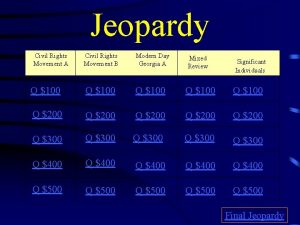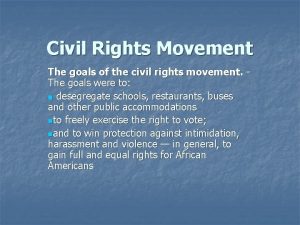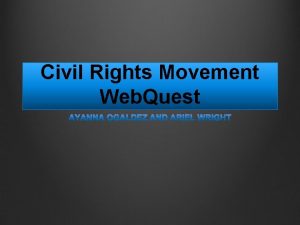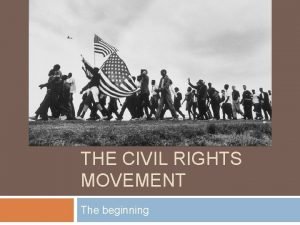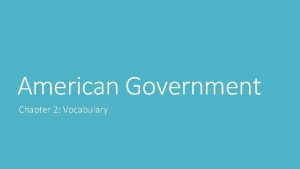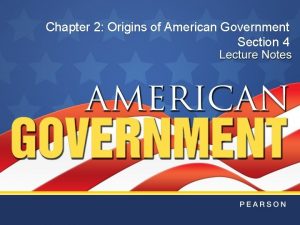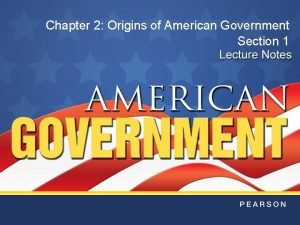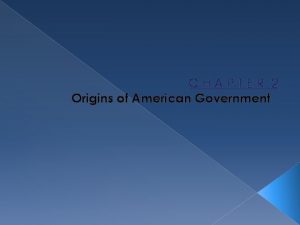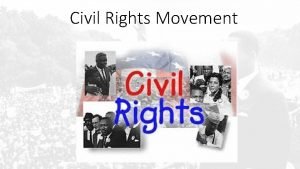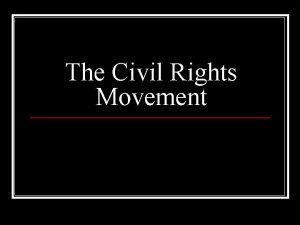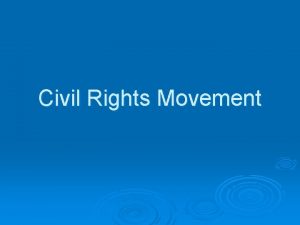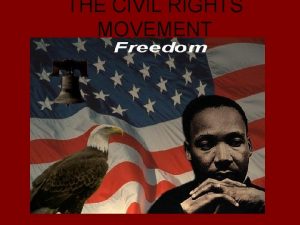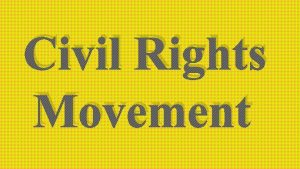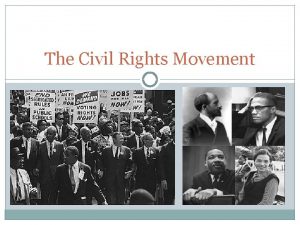Civil Rights Movement of the 1960s Origins American











- Slides: 11

Civil Rights Movement of the 1960’s

Origins… �American Indian Movement (AIM) = Red Power Movement �Formed in Minneapolis, MN in 1968 �Begins to spread across the country within 2 years, i. e. Cleveland, OH �Gains publicity through the media � 1970 American Indian Press Association (AIPA) founded- feeds Native news to papers � 2 results: public more aware of Native issues, political sympathy and awareness from Congress

Impact… � 1972 Indian Education Act = Indian parents granted greater control of children’s schools � 1976 Indian Health Care Act = attempts to address inequality in Indian health care � 1978 Indian Child Welfare Act = tribes granted control for custody issues with Indian children �Williams vs. Lee (1959) = tribal courts can rule on cases with non-Indians �Menominee Tribe vs. US (1968) = federal govt. cannot invalidate hunting and fishing rights granted via treaties �Courts allow casinos, cigarette sales, and levying taxes on tribal land

Civil Rights legislation �July 2 nd, 1964 Civil Rights Act signed into law by President Johnson �act outlawed segregation in businesses such as theaters, restaurants, and hotels �banned discriminatory practices in employment �ended segregation in public places such as swimming pools, libraries, and public schools

Voting Act of 1965 �August 6 th, 1965 bill signed into law by President Johnson �Outlaws literacy tests �National poll taxes abolished by 24 th amendment in 1964 �Federal examiners appointed (can register voters) �Harper v. Virginia State Board of Elections (1966) bans state and local poll taxes

Challenges to Jim Crow laws �Rosa Parks Dec. 1 st, 1955 �Arrested, fingerprinted, and jailed �Feb. 1 st, 1960 Woolworth “sit-in” in Greensboro, N. C. �“Freedom riders” sponsored by CORE (Congress of Racial Equality )

Dr. Martin Luther King, Jr. �January 15, 1929 -April 4, 1968 �Montgomery Bus boycott, lasted 380 days � 1 st “big” nonviolent protest �King’s leadership in the boycott was key �Elevates him to national spotlight

Nonviolent protest �Tradition taken from the teachings of Christianity (love your enemies) and Ghandi (nonviolent protests) �Creates a passive aggressive way to pressure legislatures to change civil rights laws

Malcom X �born Malcolm Little on May 19, 1925 in Omaha, Nebraska � 7 years prison for buglary �Upon release avid member of NOI (nation of Islam) �Breaks with NOI due to leader’s immorality and lies �Begins to preach integration �Assassinated Feb. 21 st, 1965

Black Power Movement �James Meredith, 1 st black student at Univ. of Miss. , gets assassinated �Stokely Carmichael of SNCC creates phrase “black power” �Emphasis on racial pride �Denounced by MLK Jr. �Beginning of a movement

Black Panthers �Huey Newton and Bobby Seale founders in Oakland, CA in Oct. 1966 �Openly took up arms to aid their communities against police brutality �Police and Black Panthers fought across the country �FBI integrated and aided in its demise
 Civil rights webquest
Civil rights webquest Mother of the modern day civil rights movement
Mother of the modern day civil rights movement Civil rights movement jeopardy
Civil rights movement jeopardy Civil rights movement goal
Civil rights movement goal Civil rights movement vocabulary
Civil rights movement vocabulary Civil rights movement webquest
Civil rights movement webquest The civil rights movement
The civil rights movement Civil rights movement essential questions
Civil rights movement essential questions Chapter 2 origins of american government vocabulary
Chapter 2 origins of american government vocabulary Origins of american government section 4
Origins of american government section 4 Chapter 2 origins of american government answer key
Chapter 2 origins of american government answer key Chapter 2 origins of american government worksheet answers
Chapter 2 origins of american government worksheet answers


